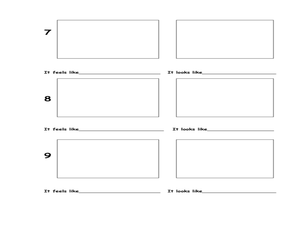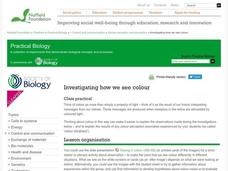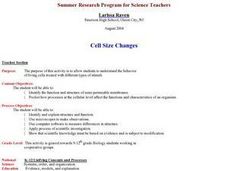Curated OER
What Do We Have In Common?
Seventh graders perform a dissection on a mussels and label their internal organs. In groups, they compare and contrast the mussels structure to those of human beings. They also review the functions that are necessary for survival and...
Curated OER
Anolis Lizards of the Greater Antilles
Learners "take a trip" to the Greater Antilles to observethe Anolis lizards. They study the body structures and habitat of different species, then plot this data on a map to look for patterns in their distribution. From the patterns they...
Curated OER
Lifecycle of Painted Lady Butterflies
Students make a chart of the life cycle of the painted lady butterflies that the class observes over a period of several days.
Curated OER
The Hantavirus Haunting: Solving the Case
Students engage in research about the hantavirus. They use a variety of resources to obtain information. Students distinguish the differences between hantavirus pulmonary syndrome, hantavirus transmission, and hantavirus prevention.
Curated OER
Field Of Beans
Students investigate the concept of crop farming. They plant small fields to test different theories of agriculture. Students keep care over the fields, including pest and weed control. Students make and record daily observations to...
Curated OER
Water Cycle Column
Students use common materials to construct a working model of the water cycle. They then observe and explain evaporation, condensation, precipitation and percolation as aspects of a continuing cycle. Students also complete worksheets and...
Curated OER
Genetics and Hypermedia
Students view presentations created by HyperCard and HyperStudio. They observe the multimedia presentation regarding Genetics. They observe the information in regards to their current unit.
Curated OER
Find Your Peanut
Sixth graders are given a peanut and is asked to study it carefully. They put their peanuts in a bag and they are mixed up. Students are then asked to find their own peanuts. They make careful observations in order to distinguish between...
Curated OER
Mechanism of Our Eyes
Students study the eye as the organ of vision, They look at a drawing of the eyes and study the names of the parts. While working with a partner, they observe what happens when the lights are turned lower and lower. Finally, they look at...
Curated OER
Wandering Wild-oats
Students observe wild-oat seeds. In this biology lesson plan, students watch how wild-oat seeds react to moisture and draw conclusions and make predictions.
Curated OER
Growing Plants with Worm Castings
Students test worm castings for content and use them to grow seeds. They hypothesize which castings best sustain seed growth. They observe growing plants to test their hypotheses. Later they graph their data.
Curated OER
Dishing the Dirt Part 2
Students explore the differences between specific soil characteristics. They participate in an experiment in which they discover soil texture. They write their observations in a journal.
Curated OER
E.coli and their Human Environment
Students observe how environmental changes (antibiotics) can affect the growth of E.coli, the rod shaped intestinal bacterium. They use the "F" test for statistical analysis. Students
Curated OER
Efficiency Means Getting More for Less
Students measure water and make predictions about efficiency.
Curated OER
Exploring Marine Objects
Students identify the sources of water on Earth. In this life science lesson, students list the different plants and animals that live in the ocean. They explore marine objects in the lab and draw them.
Curated OER
Visualizing a Human Gene with Its Introns & Exons
Students examine the entire DNA base sequence of the human adenosine deaminase gene after it is printed out from the source disk provided. The enormous length of a single gene as well as the immense difference in length between intron...
Curated OER
Goobers. Goobers? Goobers!
Young scholars begin the lesson by noting the many ways in which to use peanuts. In groups, they use the internet to research the work of George Washington Carver. They discover the allergies and nutritional information of the peanut and...
Nuffield Foundation
Investigating How We See Colour
Can you eyes be fooled into seeing colors that aren't actually there? Budding scientists view a presentation that addresses this topic. They explore how their eyes interpret color through the retinas and messages sent to the brain. They...
Virginia Department of Education
DNA Structure, Nucleic Acids, and Proteins
What is in that double helix? Explain intricate concepts with a variety of creative activities in a lesson that incorporates multiple steps to cover DNA structure, nucleic acids, and proteins. Pupils explore the history of DNA structure,...
Curated OER
Introduction to Nutrition
Fourth graders take a closer look at the foods they eat and the nutritional value of each. This lesson helps them see why foods are grouped together the way they are and what types of nutrition are provided by these food groups. They...
Curated OER
The Food Pyramid
Learning about nutrition and how to eat healthy foods is very important for kids these days. Here is a lesson, designed for 4th graders, that teaches these important skills. Pupils plan nutritional meals by using the USDA's Food Guide...
Curated OER
Food Chains
Learners take a look at the relationship between organisms in food chains, food webs, and energy pyramids. After an opening demonstration by the teacher, pupils are split up into groups. Each one is assigned an environment such as:...
Virginia Department of Education
Mendelian Genetics
How did Mendel know which pea plants would demonstrate certain characteristics? Pupils explore the answer this question, among others, as they complete Punnet squares, research dominant and recessive traits, and explore hereditary...
Curated OER
Cell Size Changes
Learners examine the behavior of living cells treated with different types of stimuli. They watch an online movie, examine wet mount slides under a microscope, take an online quiz, and analyze data.

























